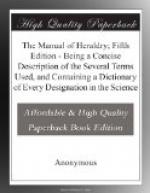Arms of Concession are arms granted by sovereigns as the reward of virtue, valour, or extraordinary service. All arms granted to subjects were originally conceded by the Sovereign.
Arms of Community are those of bishoprics, cities, universities, academies, societies, and corporate bodies.
Arms of Patronage are such as governors of provinces, lords of manors, &c., add to their family arms as a token of their superiority, right, and jurisdiction.
Arms of Family, or paternal arms, are such as are hereditary and belong to one particular family, which none others have a right to assume, nor can they do so without rendering themselves guilty of a breach of the laws of honour punishable by the Earl Marshal and the Kings at Arms. The assumption of arms has however become so common that little notice is taken of it at the present time.
Arms of Alliance are those gained by marriage.
Arms of Succession are such as are taken up by those who inherit certain estates by bequest, entail, or donation.
Shields, tinctures, furs, &c.
The Shield contains the field or ground whereon are represented the charges or figures that form a coat of arms. These were painted on the shield before they were placed on banners, standards, and coat armour; and wherever they appear at the present time they are painted on a plane or superficies resembling a shield.
[Illustration: Escutcheon]
[Illustration: Lozenge]
Shields in Heraldic language are called Escutcheons or Scutcheons, from the Latin word scutum. The forms of the shield or field upon which arms are emblazoned are varied according to the taste of the painter. The Norman pointed shield is generally used in Heraldic paintings in ecclesiastical buildings: the escutcheons of maiden ladies and widows are painted on a lozenge-shaped shield. Armorists distinguish several points in the escutcheon in order to determine exactly the position of the bearings or charges. They are denoted in the annexed diagram, by the first nine letters of the alphabet ranged in the following manner:
[Illustration]
|-----------------| | A B C | A, the dexter chief. | | B, the precise middle chief. | D | C, the sinister chief. | | D, the honour point. | E | E, the fess point. | | F, the nombril point. | F | G, the dexter base. | | H, the precise middle base. | G H I | I, the sinister base. \ / \ --------- /
The dexter side of the escutcheon answers to the left hand, and the sinister side to the right hand of the person that looks at it.




